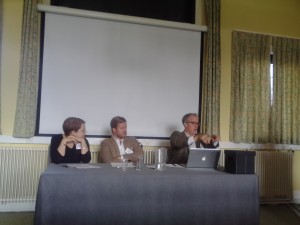Text: Hanne Appelqvist
Work on a theoretical concept can easily be hampered by the kinds of examples we treat as paradigm instances of that concept. This is because our intuitions, feelings, and attitudes regarding the chosen examples direct our vision, and do so for better and for worse. A concept like recognition is especially susceptible to this, as it applies to human communities, traditions, and worldviews, as well as to our friends, family, and even ourselves as members of those groups seeking or granting recognition. One countermeasure against the possible bias resulting from our personal involvement is to consider the relevant concept in a neutral context that does not carry the connotations preventing a clear view of the phenomenon under investigation. This is what Professor Jonathan Neufeld (College of Charleston), Professor Brian Soucek (UC Davies Scool of Law), and I sought to do in a panel titled Aesthetic Obedience and Disobedience, presented at the BSA Annual Conference at Homerton College, Cambridge. Focusing on philosophy of art we asked (i) what it means to recognize an object as a work of art; (ii) what role might art play in public deliberation including the recognition of under-represented groups; and (iii) whether the fact that something is recognized as art justifies its exemption from certain legal obligations including laws against the discrimination against minorities.
The panel began with my own paper “On the Quest for a Common Standard: Wittgenstein and Kant on the Rules of Art”. Drawing on the work of these two formalists, I argued that one can neither understand nor evaluate art without acknowledging and mastering the rules of the relevant tradition. However, if Kant and Wittgenstein are right, the rules of art are quite peculiar, as they cannot be couched in conceptual formulas but must be read from the works themselves. Hence, the understanding of art cannot be acquired by consulting a manual or by imitating others, but requires one’s personal and practical immersion in the aesthetic system constituted by its nonconceptual, specifically artistic rules. If there is no common standard – not even one as formal and empty of empirical content as the Kantian principle of purposiveness without purpose – then our responses to works of art are no more than random likes or dislikes in the newsfeed of social media. And the works of art, they may be “anything or nothing at all” to borrow Wittgenstein’s expression.
While the beauty of such a Kantian view lies in the pure formality of the rules of art, the view may also be criticized for its inability to pay due respect to the relation between art and society as a whole – just like the Kantian notion of respect we owe to others as rational agents has been criticized for its disregard for the historical and cultural situatedness of people. Jonathan’s paper “Aesthetic Civil Disobedience” presented powerfully the case of art’s role in public deliberation, arguing that works of art do not have to be reduced to mere didactic tools of various political agendas but can actually function as engines of societal change via their aesthetic properties. In support of this claim, Jonathan offered an analysis of aesthetic civil disobedience by discussing such cases as Pussy Riot, the (illegal) placing of a finely carved statue of Edward Snowden on a War of Independence memorial in Brooklyn NY (see picture below), and the presentation of pictures of African-American community leaders next to statues memorializing leaders of the Confederacy on Monument Avenue in Richmond, Virginia. While all instances make specific demands for political recognition, these acts of aesthetic civil disobedience are not reducible to discursive reasons that could be translated into written manifestos. Instead, the aesthetic form of the acts or artworks is an integral part of their public communicative function.
Brian’s paper “Artwork Exceptionalism” introduced the phenomenon of misrecognition to the discussion by analyzing cases where an otherwise generally applicable law is taken not to apply to art. Hence, for example, a junked car in one’s front yard may be exempt from the law prohibiting the storage of junked cars on front yards, if it happens to be, not just a junked car, but a work of art made out of one by being painted and filled with flowers. Such cases may seem innocent enough, but they force the judicial system to deliberate what counts as art and what not, and what type of art is aesthetically significant enough to warrant an exemption – a task which at the outset seems more suited for philosophers of art than a court of law. Moreover, the innocuousness of the junked car case soon fades away when we see the structural parallel between such “artwork exceptionalism” and “religious exceptionalism”, a recently hot legal topic in the US. We may well learn to live with a junked car transfigured into an artwork on our neighbor’s front yard, because we want to guard the freedom of artistic expression in our society. But what are we supposed to think of the analogous case of court granting exemption from the law prohibiting discrimination against sexual minorities for a wedding photographer who, appealing to his religious beliefs, refuses to take photos at a same sex wedding? As demonstrated by Brian’s paper, the case is tricky, “for just as any object, arguably, can become an artwork, so might any action be an exercise of religion – even filicide, as Abraham can attest”.
Hanne Appelqvist (2013) “Wittgenstein and the Limits of Musical Grammar”, The British Journal of Aesthetics 53 (3), pp. 299–319.
Jonathan Neufeld (2015) “Aesthetic Disobedience”, The Journal of Aesthetics and Art Criticism 73 (2), pp. 115–125.
Brian Soucek (2014) “Aesthetic Judgment in Law” and “Personification of Art”, in Michael Kelly (ed.) Oxford Encyclopedia of Aesthetics (2d ed.) (Oxford: OUP).


